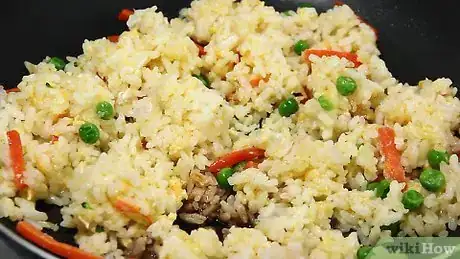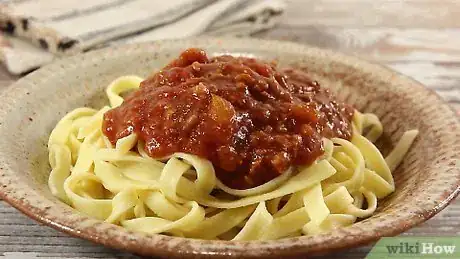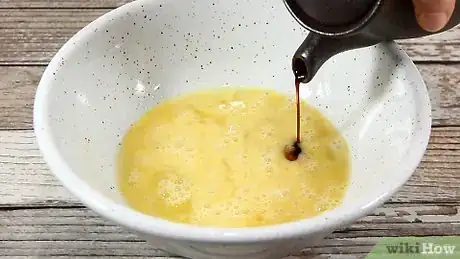This article was co-authored by wikiHow Staff. Our trained team of editors and researchers validate articles for accuracy and comprehensiveness. wikiHow's Content Management Team carefully monitors the work from our editorial staff to ensure that each article is backed by trusted research and meets our high quality standards.
There are 7 references cited in this article, which can be found at the bottom of the page.
The wikiHow Video Team also followed the article's instructions and verified that they work.
This article has been viewed 56,773 times.
Learn more...
Soy sauce is an incredibly versatile ingredient that adds flavor to a wide variety of dishes. You can use soy sauce as a condiment for many different meals, or you can cook with soy sauce to give make your food even more delicious. It’s easy to get your money’s worth when you pick up a bottle of soy sauce at the supermarket!
Steps
Using Soy Sauce as a Condiment
-
1Cover your rice-based dishes in soy sauce to top off your dish. Fried rice meals go great with soy sauce, as the two complement each other well. Start by adding 1 tablespoon (15 mL) to your food. If you don’t think that this is enough, you can always add more after doing a small taste test.[1]
- Soy sauce has a fairly high salt content, so don’t overuse it. Too much soy sauce can zap the flavor from your meal.
Tip: To really mix soy sauce into your food, put your meal in a container and add the soy sauce. Then, close the container with a lid and shake it for about 2 minutes. This spreads the condiment around and gives the soy sauce a chance to seep into all parts of your food.
-
2Douse noodle-based dishes in soy sauce. Stir fry is a fantastic example of a meal that goes great with soy sauce. Splash about 1 tablespoon (15 mL) of soy sauce onto your dish. Make it a point to spread the soy sauce around your stir fry to try and cover as much of the food as possible. Test out the soy sauce by tasting your stir fry.[2]
- You can always add more soy sauce to your stir fry, but you can’t remove soy sauce if you feel you’ve added too much. This is why you should start with a relatively small amount, like 1 tablespoon (15 mL) and work your way up from there.
Advertisement -
3Dip egg or spring rolls into soy sauce for added flavor. Soy sauce can be a great dipping sauce for snacks like spring rolls. Fill a small bowl with about 2 tablespoons (30 mL) of soy sauce and dip away![3]
- If you order out, these foods come with packets of soy sauce. Cut off the top part of the packets with scissors and pour them into a small bowl to use the soy sauce as dipping sauce.
-
4Put soy sauce in salads to add richness and complexity to the dish. If you’re making a vinaigrette salad dressing, adding a few drops of soy sauce to it will bring out another layer of flavor. Be sure to add the soy sauce before putting any salt in, otherwise you run the risk of over-seasoning your food.[4]
- If you want to try this, you don’t need to put any salt in your salad dressing.
-
5Mix in soy sauce to create a flavorful barbeque sauce. One recipe calls for 2 cups (470 mL) of ketchup, 3 tablespoons (44 mL) of brown sugar, and 2 tablespoons (30 mL) of soy sauce as a base. From there, add 2 tablespoons (30 mL) of apple cider vinegar, 2 teaspoons (9.9 mL) of minced garlic, and 0.125 teaspoons (0.62 mL) of red pepper flakes. Put all these ingredients in a medium-sized saucepan and bring the mixture to a simmer over medium-low heat. Continue simmering for 15 minutes, then remove the pan from the heat and allow the sauce to cool for 15 minutes.[5]
- If you’d like, you can add more red pepper flakes for taste.
- Keep this sauce refrigerated in an air-tight container and make sure you finish it up within a week. Otherwise, it will go bad.
Cooking with Soy Sauce
-
1Add it to meat sauce for pasta. One great thing about soy sauce is that a little bit goes a long way. Simply add 1 tablespoon (15 mL) to your entire pot of meat sauce and stir for 5 minutes to mix the soy sauce in.[6]
- Make sure to add the soy sauce before the salt if you’re using salt in the first place. Since soy sauce has a fairly high salt content, you actually don’t need to add any salt at all.
-
2Make soy-roasted nuts for a hearty, flavorful snack. Soy sauce works great as a salt substitute because it adds an extra layer of flavor that salt simply cannot provide. Take a pack of almonds of peanuts, put them in a bowl, and soak them in soy sauce for 1-2 hours. Then, set your oven to 150 °F (66 °C) and dry-roast the nuts for 4-5 hours.[7]
- You can use any kind of nut you’d like, almonds and peanuts are just two examples!
Tip: An alternative to this snack is to toss almonds, peanuts, or any kind of nut in soy sauce by putting the nuts in a container, adding 2 tablespoons (30 mL) of soy sauce, closing the container, and shaking it for 5 minutes before putting the contents in the oven for 3-4 hours. This method will save you some time, so you can start snacking even sooner.
-
3Infuse soup broth with soy sauce to enrich a soup or stew. Soups with thin broths aren’t very enjoyable to consume. By putting 2 tablespoons (30 mL) of soy sauce in the broth, you’ll make it thicker and give it an added punch of flavor.[8]
- For example, you can add soy sauce when making hot and sour soup to deepen the flavor of the dish.
- If you’re new to soy sauce, consider adding just 1 tablespoon (15 mL) of soy sauce to see if you like it. You can always add more later or to your next batch of soup!
-
4Season scrambled eggs with soy sauce instead of salt. Crack 2-3 eggs and whip them up with a whisk in a bowl. Then, add a few drops of soy sauce and continue to whisk the eggs. This gives you seasoning from the start as opposed to an uneven layer of salt on top of the eggs.[9]
- You can use tamari sauce to keep your dish gluten-free.
-
5Braise pork in sweet soy sauce for a simple but filling meal. Get a 2 pounds (0.91 kg) pork loin and chop it up into cubes that are 1 in (2.5 cm) long and 1 in (2.5 cm) wide. Put a few drops of olive oil in a large skillet and heat it over medium or high heat. Then, add the pork and cook it until it’s no longer pink. While the pork is cooking, mix the rest of the ingredients in a medium-sized bowl. Turn the heat to low and let the dish simmer for 30 minutes.[10]
- The recipe calls for 0.5 cups (120 mL) of soy sauce, 2 tablespoons (30 mL) of vegetable oil, 1 tablespoon (15 mL) of garlic and ginger paste, 1 tablespoon (15 mL) of olive oil, 1 tablespoon (15 mL) of sesame oil, 4 tablespoons (59 mL) of sugar, 1.5 cups (350 mL) of water, and 1 tablespoon (15 mL) of chili garlic sauce.
- It should take about 3 minutes for the pork to no longer be pink.
- You can garnish this dish with parsley or green onions and serve it over a bed of steamed rice.
References
- ↑ https://www.onegreenplanet.org/vegan-food/condiments-for-veggie-dishes/
- ↑ https://www.cookingchanneltv.com/devour/recipes/2014/12/how-to-use-soy-sauce
- ↑ https://www.bonappetit.com/story/how-to-use-soy-sauce
- ↑ https://www.bonappetit.com/story/how-to-use-soy-sauce
- ↑ https://www.kitchentreaty.com/our-very-favorite-homemade-barbecue-sauce/
- ↑ https://www.buzzfeed.com/rafaelcapanema/soy-unbelievable
- ↑ https://www.seriouseats.com/2014/06/what-can-i-do-with-soy-sauce.html
- ↑ https://www.bonappetit.com/story/how-to-use-soy-sauce
- ↑ https://www.seriouseats.com/2014/06/what-can-i-do-with-soy-sauce.html






















































